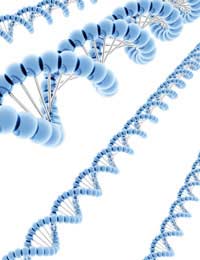The Properties of DNA

DNA has a number of special physical and chemical properties that are important to its structure and functioning. While the terms may sound quite foreign and perhaps even complicated, they are significant to our understanding of DNA and its many applications today.
Physical Properties
In living organisms such as humans, DNA exists as a pair of molecules rather than a single molecule. These strands are entwined in the shape of a double helix and the helix is kept stable by hydrogen bonds, which can be found between the bases attached to the two strands. A long polymer, DNA is made up of smaller units called nucleotides. In turn, each nucleotide consists of a phosphate group, a sugar and a nitrogenous base. To get a sense of just how long a DNA polymer is, consider that just one human chromosome is several hundred million base pairs long.Base Pairing
Base pairing is a defining property of DNA and was particularly exciting when it was first discovered because it suggested the 'copying' mechanism for DNA. In DNA, bases are specific in that an adenine base, for example, only pairs with a thymine base. Following on that premise, a cytosine base will only bond to a guanine base. This base pairing is also known as complementary base pairing. The concept is quite simplistic but it is significant for DNA.DNA Grooves
DNA has two kinds of grooves that play important roles in its functioning. Major and minor grooves are structures to allow for necessary proteins in your body to make contact with bases. You might wonder what makes it so important for proteins to attach to the bases. Some of these proteins are called transcription factors. While the word may well be a foreign one for those unfamiliar with DNA - which is most of the public - it is a key one. Transcription factors have numerous roles such as telling your cells how large they should become or suppressing tumour growth. They are also significant for cell development and communication. As such, these DNA grooves seen in the structure of DNA facilitate the binding of proteins like transcription factors, which then serves to keep the cellular processes occurring effectively within your body.DNA Supercoiling
If you try to picture a rope, you can get a visual image of DNA supercoiling. This coiling is a central property of DNA. DNA can be in a relaxed or coiled state and it is this coiling that allows our extremely long strands of DNA to fit or 'pack' into the comparatively much smaller cells in our bodies. This supercoiling property makes DNA more efficient by allowing it to make better use of space and fit neatly into a significantly smaller space relative to its relaxed, longer size.DNA Conformations
DNA can exist in different conformations and these are important for a range of DNA mechanisms. These conformations interact with enzymes in your body and are also involved in aspects such as DNA repair.DNA Sense and Antisense
To understand this aspect of DNA, you first need to be aware of RNA - ribonucleic acid. DNA holds the genetic 'codes' to make RNA. In turn, RNA is needed in your body because it holds the codes for the amino acids that make proteins. The antisense strand is the DNA strand that carries important information to make proteins by binding to the RNA. This antisense strand is the key for making proteins. In comparison, the sense strand is the one that does not code for RNA.Despite the complex detail and challenges that come with understanding the properties of DNA, they are clearly important to its design and functioning in the human body. Since the discovery of DNA and our knowledge of its basic physical properties such as the double helix, we have progressed a great deal to learning about the chemical properties of DNA and interactions between DNA and its environment. Hopefully, we will learn even more detailed information about DNA structure and functioning in the future, which will have important applications in disease treatment and many other fields.


Re: How was DNA Discovered?
DNA is not a real thing, the earth is flat, the sun is blue
Re: An Overview of DNA Functions
I tried to extract DNA from my refrigerator, now I have no refrigerator and my food is rotting.
Re: The Properties of DNA
what are 5 characteristics of DNA?
Re: How was DNA Discovered?
betty for the last time im trying to sleep bugger of babe
Re: How was DNA Discovered?
It is past you bedtime winnie pleas go to bved now or no france for you go back to easter island looser!!!
Re: How was DNA Discovered?
My bed time is at 9:00 and it is 9.01 in indea at the moment> i am sooooooooo naughty
Re: How was DNA Discovered?
ICE ICE DAVEY
Re: How was DNA Discovered?
This sorkis absalutely propostuous I found out about DNAfirst these loosers lied
Re: How was DNA Discovered?
meow
Re: How was DNA Discovered?
this workis realy interresting i would love to disscus more about this with you